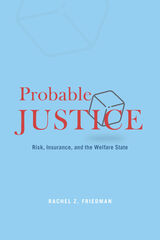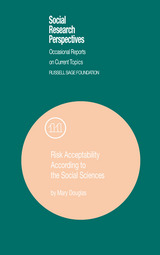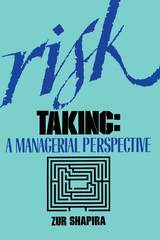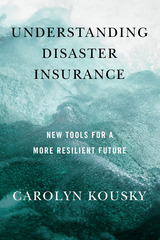6 books about Risk Assessment & Management

Probable Justice
Risk, Insurance, and the Welfare State
Rachel Z. Friedman
University of Chicago Press, 2020
Decades into its existence as a foundational aspect of modern political and economic life, the welfare state has become a political cudgel, used to assign blame for ballooning national debt and tout the need for personal responsibility. At the same time, it affects nearly every citizen and permeates daily life—in the form of pension, disability, and unemployment benefits, healthcare and parental leave policies, and more. At the core of that disjunction is the question of how we as a society decide who should get what benefits—and how much we are willing to pay to do so.
Probable Justice traces a history of social insurance from the eighteenth century to today, from the earliest ideas of social accountability through the advanced welfare state of collective responsibility and risk. At the heart of Rachel Z. Friedman’s investigation is a study of how probability theory allows social insurance systems to flexibly measure risk and distribute coverage. The political genius of social insurance, Friedman shows, is that it allows for various accommodations of needs, risks, financing, and political aims—and thereby promotes security and fairness for citizens of liberal democracies.
Probable Justice traces a history of social insurance from the eighteenth century to today, from the earliest ideas of social accountability through the advanced welfare state of collective responsibility and risk. At the heart of Rachel Z. Friedman’s investigation is a study of how probability theory allows social insurance systems to flexibly measure risk and distribute coverage. The political genius of social insurance, Friedman shows, is that it allows for various accommodations of needs, risks, financing, and political aims—and thereby promotes security and fairness for citizens of liberal democracies.
[more]

Risk Acceptability According to the Social Sciences
Mary Douglas
Russell Sage Foundation, 1985
Every day, it seems, we become aware of some new technological or chemical hazard. Yet it is also possible that this very awareness is new, or at least newly heightened. Why are certain kinds of risks suddenly so salient? Are public perceptions of risk simply the sum of individual reactions to individual events, or do social and cultural influences play a role in shaping our definitions of safety, acceptable risk, and danger? Prompted by public outcries and by the confusion and uncertainty surrounding risk management policy, social scientists have begun to address themselves to the issue of risk perception. But as anthropologist Mary Douglas points out, they have been singularly reluctant to examine the cultural bases of risk perception, preferring to concentrate on the individual perceiver making individual choices. This approach leaves unexamined a number of crucial social factors—our concepts of what is "natural" or "artificial," for example; our beliefs about fairness, and our moral judgements about the kind of society in which we want to live. This provocative and path-breaking report seeks to open a sociological approach to risk perception that has so far been systematically neglected. Describing first some exceptions to the general neglect of culture, Douglas builds on these clues and on her own broad anthropological perspective to make a compelling case for focusing on social factors in risk perception. She offers a challenge and a promising new agenda to all who study perceptions of risk and, by extension, to those who study human cognition and choice as well. "An altogether brilliant piece of writing—far-reaching and a joy to read." —Amartya Sen, Oxford University A Volume in the Russell Sage Foundation's Social Science Frontiers Series
[more]

Risk Management and Political Culture
Sheila Jasanoff
Russell Sage Foundation, 1986
This unique comparative study looks at efforts to regulate carcinogenic chemicals in several Western democracies, including the United States, and finds marked national differences in how conflicting scientific interpretations and competing political interests are resolved. Whether risk issues are referred to expert committees without public debate or debated openly in a variety of forums, patterns of interaction among experts, policy makers, and the public reflect fundamental features of each country's political culture. "A provocative argument....Poses interesting questions for the sociology of science, especially science produced for public debate."—Contemporary Sociology A Volume in the Russell Sage Foundation's Social Science Frontiers Series
[more]

The Risk Professionals
Thomas Dietz
Russell Sage Foundation, 1987
In the two decades since a new social movement put environmental issues high on the national policy agenda, Washington has become home to a small group of people—the risk professionals—whose careers center on the identification, assessment, and management of risks to public health and safety. These men and women, experts working in federal agencies, Congress, activist organizations, and corporations, help transform mass concern into government policy, shaping the way our society responds to environmental and technological hazards. Based on nearly 230 interviews, The Risk Professionals provides the first comprehensive sociological analysis of our "danger establishment." Dietz and Rycroft explore the social, educational, and career profiles of risk professionals; their worldviews and ideologies; their networks and norms. Not content to view risk professionals from a single perspective, the authors build an integrated description that considers commonalities in their subjects' backgrounds, interests, values, and communication patterns. The result is a uniquely revealing look into the heart of the risk policy system, and a broader illumination of the social structures and dynamics that will influence environmental policy for years to come. A Volume in the Russell Sage Foundation's Social Science Frontiers Series
[more]

Risk Taking
A Managerial Perspective
Zur Shapira
Russell Sage Foundation, 1995
Classical economic theory assumes that people in risk situations follow a course of action based on a rational, consistent assessment of likely outcomes. But as Zur Shapira demonstrates in Risk Taking, corporate managers consistently stray from the prescribed path into far more subjective territory. Risk Taking offers a critical assessment of the relationship between theory and action in managerial decision making. Shapira offers a definitive account of the classical conception of risky decision making, which derives behavioral prescriptions from a calculation of both the value and the likelihood of possible outcomes. He then demonstrates how theories in this vein have been historically at odds with empirical observations. Risk Taking reports the results of an extensive survey of seven hundred managers that probed their attitudes and beliefs about risk and examined how they had actually made decisions in the face of uncertainty. The picture that emerges is of a dynamic, flexible process in which each manager's personal expertise and perceptions play profound roles. Managerial strategies are continually modified to suit changing circumstances. Rather than formulating probability estimates, executives create potential scenarios based not only on the possible outcomes but also on the many arbitrary factors inherent in their own situations. As Shapira notes, risk taking propensities vary among managers, and the need to maintain control and avoid particularly dangerous results exercises a powerful influence. Shapira also examines the impact of organizational structure, long-term management objectives, and incentives on decision making. With perceptive observations of the cognitive, emotional, and organizational dimensions of corporate decision making, Risk Taking propels the study of managerial risk behavior into new directions. This volume signals the way toward improving managerial decision making by revealing the need for more inclusive choice models that augment classical theory with vital behavioral observations.
[more]

Understanding Disaster Insurance
New Tools for a More Resilient Future
Carolyn Kousky
Island Press, 2022
The frequency and intensity of natural disasters—such as wildfires, hurricanes, floods, and storms—is on the rise, threatening our way of life and our livelihoods. Managing this growing risk will be central to economic and social progress in the coming decades. Insurance, an often confusing and unpopular tool, will be critical to successfully emerging from the effects of these crises. Its traditional role is to protect us from unforeseen and unanticipated risk, but as currently structured, insurance cannot adequately respond to these types of threats. How can we improve insurance to provide consistent and sufficient help following all disasters? How do we use insurance not just to help us recover, but also to help us prevent disasters in the first place? And how can insurance help us achieve broader social and environmental goals?
Understanding Disaster Insurance provides an accessible introduction to the complexities—and exciting possibilities—of risk transfer markets in the U.S. and around the world. Carolyn Kousky, a leading researcher on disaster risk and insurance, explains how traditional insurance markets came to be structured and why they fall short in meeting the needs of a world coping with climate change. She then offers realistic, yet hopeful, examples of new approaches. With examples ranging from individual entrepreneurs to multi-country collaborations, she shows how innovative thinking and creative applications of insurance-based mechanisms can improve recovery outcomes for people and their communities. She also explores the role of insurance in supporting policy goals beyond disaster recovery, such as nature-positive approaches for larger environmental impact. The book holds up the possibility that new risk transfer markets, brought to scale, could help create more equitable and sustainable economies.
Insurance and risk transfer markets can be a powerful tool for adapting to climate change, yet they are frequently misunderstood. Many find insurance confusing or even problematic and ineffective. Understanding Disaster Insurance is a useful guidebook for policymakers, innovators, students, and other decision makers working to secure a resilient future—and anyone affected by wind, fire, rain, or flood.
Understanding Disaster Insurance provides an accessible introduction to the complexities—and exciting possibilities—of risk transfer markets in the U.S. and around the world. Carolyn Kousky, a leading researcher on disaster risk and insurance, explains how traditional insurance markets came to be structured and why they fall short in meeting the needs of a world coping with climate change. She then offers realistic, yet hopeful, examples of new approaches. With examples ranging from individual entrepreneurs to multi-country collaborations, she shows how innovative thinking and creative applications of insurance-based mechanisms can improve recovery outcomes for people and their communities. She also explores the role of insurance in supporting policy goals beyond disaster recovery, such as nature-positive approaches for larger environmental impact. The book holds up the possibility that new risk transfer markets, brought to scale, could help create more equitable and sustainable economies.
Insurance and risk transfer markets can be a powerful tool for adapting to climate change, yet they are frequently misunderstood. Many find insurance confusing or even problematic and ineffective. Understanding Disaster Insurance is a useful guidebook for policymakers, innovators, students, and other decision makers working to secure a resilient future—and anyone affected by wind, fire, rain, or flood.
[more]
READERS
Browse our collection.
PUBLISHERS
See BiblioVault's publisher services.
STUDENT SERVICES
Files for college accessibility offices.
UChicago Accessibility Resources
home | accessibility | search | about | contact us
BiblioVault ® 2001 - 2024
The University of Chicago Press









